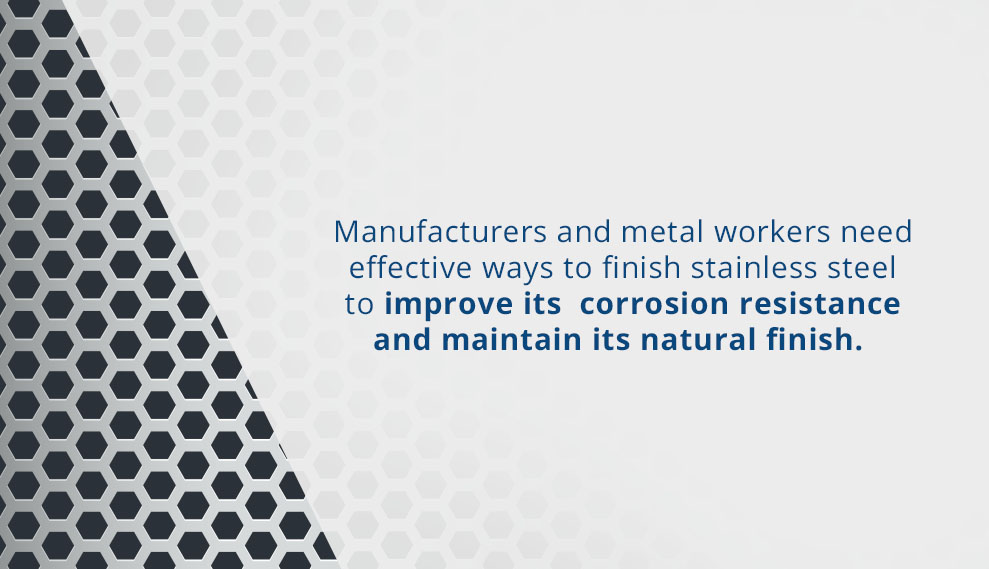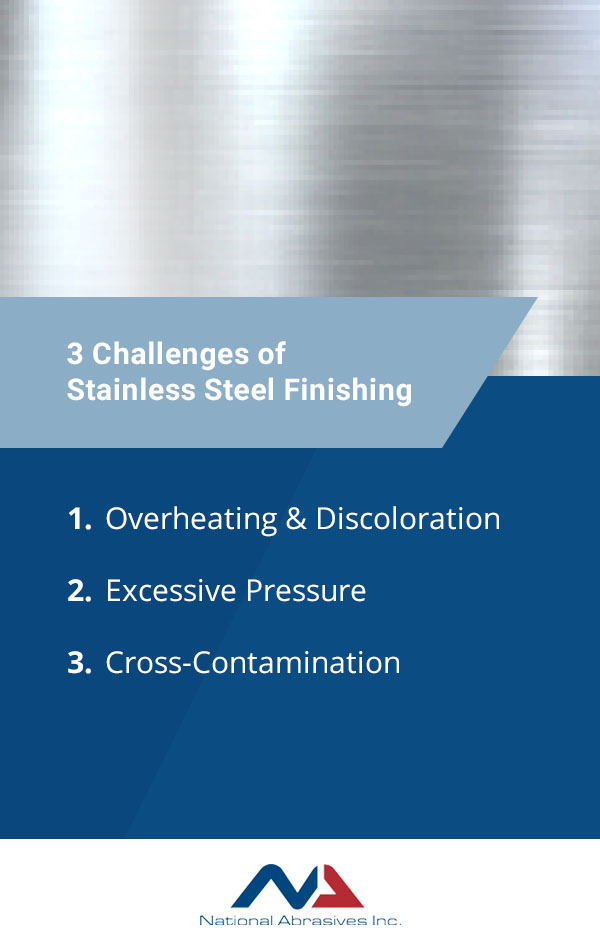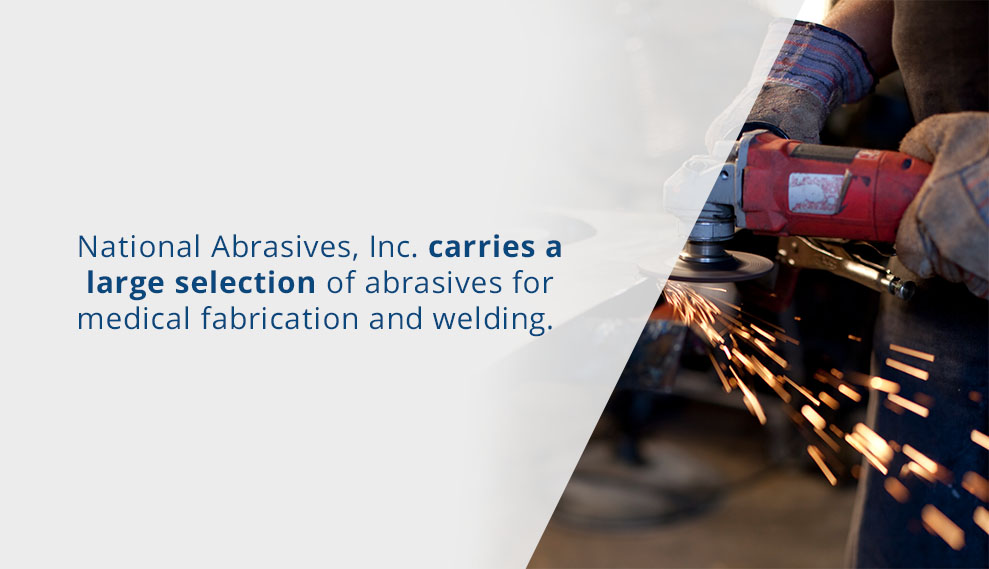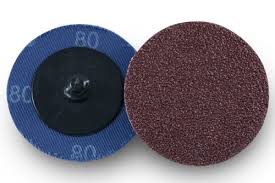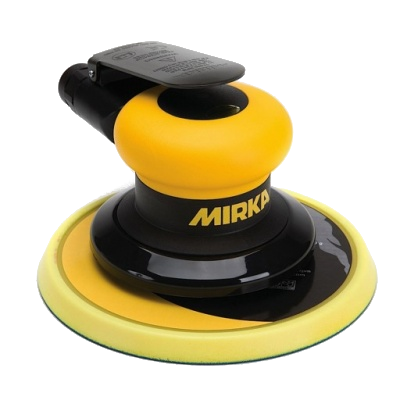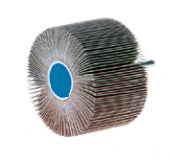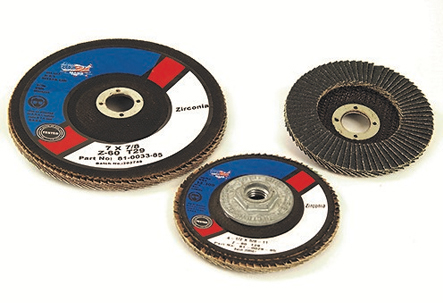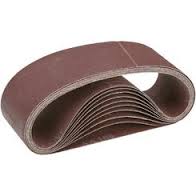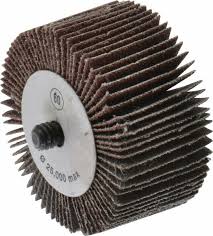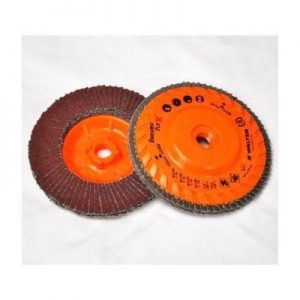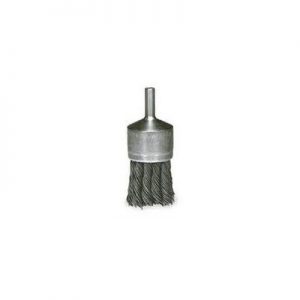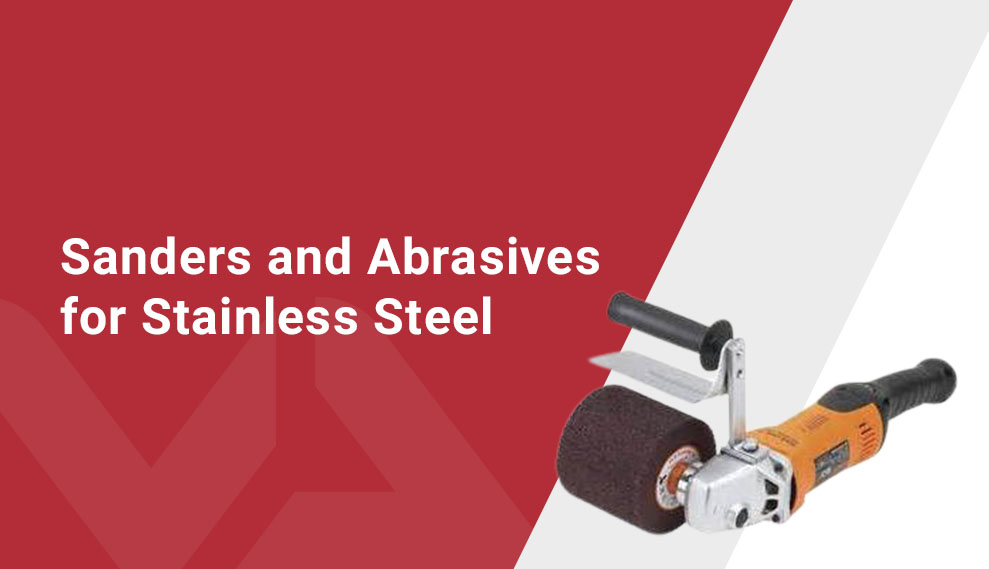
Stainless steel products are known for their sleek, polished chrome finish. What’s the best way to achieve this desired finish? Grinding and sanding stainless steel are highly effective ways to produce the finished results you want from your stainless steel welded products. To achieve the desired finish, manufacturers and metal workers need sanders and abrasives suitable for stainless steel.
Not all sanding discs and abrasives are right for stainless steel. This particular type of metal requires a specific range of abrasive grit to get a sleek and polished look that’s long-lasting. This guide to finishing stainless steel covers some of the best practices for sanding and the best abrasives and discs for finishing stainless steel.
About Finishing Stainless Steel
Manufacturers and metal workers need effective ways to finish stainless steel to improve its corrosion resistance and maintain its natural finish. After welding, stainless steel can become discolored, impacting the look of the final product. To improve the stainless steel’s finish and keep it looking attractive and high-quality, it’s important to employ the appropriate finish techniques.
These processes improve an item’s appearance by matching the color and finish of the welded areas to the rest of the surface to create a cohesive look. There are several different ways to finish stainless steel, including chemicals, pastes and electrochemical finishing. One of the more effective and long-lasting ways to finish stainless steel is through manual grinding and polishing with sanders and abrasives.
Stainless steel sanding discs and abrasives can also be used in conjunction with other finishing techniques. It’s often a multi-step process that can vary by project. To determine the right stainless steel finishing processes and products, it’s crucial to decide which type of finish you want for your product.
About Stainless Steel Finishing
According to the Specialty Steel Industry of North America (SSINA), stainless steel requires alternative considerations compared to other metal types. The first factor to keep in mind is the amount of power applied to the sanding or grinding. The stronger the metal, the more power you’ll need to remove its layers. The second consideration is that stainless steel has lower heat conductivity than carbon steel, which means that stainless steel is more susceptible to heat discoloration across its surface.
In terms of the amount of grinding effort applied to stainless steel, this variable depends on the current condition of the metal’s surface and the type of finish desired. The rougher the surface condition, the more grinding you need to apply with a coarser abrasive initially, reducing grit size in subsequent passes. This process allows you to gradually grind down the surface until you achieve the desired finish type.
Shop Abrasives for Stainless Steel Finishing
Types of Stainless Steel Finishes
Below are the most common stainless steel finishes to choose from, according to SSINA:
- No. 1: Considered a rough finish, very little finishing is required to produce a no. 1 finish. This surface will appear imperfect, with some shiny patches for an overall dark and non-uniform appearance.
- No. 2B: A brighter finish than no. 1, no. 2B is reflective but cloudy or dull. Upon close inspection, its surface appears irregular and patchy. No. 2B is a common finish on bakeware, plumbing fixtures and industrial equipment.
- No. 3: A moderately reflective finish, a no. 3 finish has coarse-textured polishing lines. These grit lines appear uniformly and parallel in direction. No. 3 finishes are commonly used in food processing and brewery equipment.
- No. 4: As a brushed satin finish, no. 4 finishes are similar to no. 3 in that they produce parallel grit lines. However, no. 4 finish grit lines are shorter and finer compared to no. 3 grit lines. No. 4 finishes are also common in food and kitchen equipment, as well as medical and scientific instruments.
- No. 7: Highly reflective and polished, no. 7 finishes are mirror-like. A no. 7 finish is achieved with increasingly finer abrasives accompanied by buffing motions and compounds. Upon close inspection, a no. 7 may have some visible but fine grit lines left over from the original surface. No. 7 finishes are common in decorative elements like trim and panels.
To achieve any of the above finishes, you need suitable metal sanding discs for your orbital sander and the right abrasives. For assistance in choosing the best abrasives and sanding discs to achieve the stainless steel finish you desire, contact an expert at National Abrasives, Inc.
3 Challenges of Stainless Steel Finishing
To achieve the proper stainless steel finish, you need the right expertise, technique and products. Stainless steel finishing is a skill that takes knowledge and practice to achieve the right finish without compromising the product. Before beginning a stainless steel finishing project, it’s important to be aware of some of the common pitfalls involved in stainless steel finishing. Anticipating these challenges in advance can help you avoid costly material loss and wasted time and effort.
Below are three of the most common challenges experienced in stainless steel finishing.
1. Overheating and Discoloration
Applying abrasives to stainless steel can lead to overheating if you’re not careful. Using sanders or belts that are set to high power levels or speeds can heat up patches of the surface, causing discoloration. This effect is known as heat tinting, which leads to higher and faster rates of rust in these vulnerable patches. Heat tinting can also occur when using the wrong abrasive or an abrasive that is too dull.
Besides heat tinting, another issue that overheating causes is that it can convert the material’s austenite into martensite, which is a brittle metal composition. This transformation alters the properties of the stainless steel, creating undue and excessive tensile stress. Using the right zirconia or ceramic abrasive products will prevent grinding burn and heat tinting.
2. Excessive Pressure
It’s important to use a smooth, even sanding technique when finishing stainless steel. Bearing down on the surface with excess pressure results in further heat discoloration. If certain patches receive more pressure than other areas, it results in an uneven color and finish. Instead, apply even pressure across the surface to prevent overworking any one area.
Using too much pressure in certain areas results in the orange peel or dimpled effect, which needs to be corrected in the final steps of finishing. This re-work increases the amount of time it takes to complete your project, reducing productivity and driving up costs. When applying the abrasive, keep the sander moving across the surface at an even rate with low pressure to prevent burning the material.
3. Cross-Contamination
Another issue that can arise during stainless steel finishing is cross-contamination between metals and abrasive products. When finishing stainless steel, iron parts or used abrasive products can transfer onto the surface material. Cross-contamination onto the stainless steel can decrease its natural corrosion-resistance properties. Punches, hammers, brushes, rolls and other finishing tools can cause these changes.
It’s essential to reserve specific abrasive and finishing products for use on stainless steel to prevent the transfer from occurring. Overused or dull abrasives can also lead to cross-contamination. Be sure to use sharp products that will not damage the stainless steel.
Overcoming Finishing Challenges With Quality Equipment
Choosing the right abrasives and power tools while perfecting your finishing technique can help you circumvent the challenges described above. Consult an abrasives expert to select the right abrasive product for finishing stainless steel to prevent heat tinting, cross-contamination and excess pressure. We encourage you to contact National Abrasives, Inc. to learn more.
5 Tips for Stainless Steel Finishing
Beyond surpassing the obstacles to effective stainless steel finishing, manufacturers and metal workers should be aware of the best practices for proper finishing. An excellent stainless steel finish starts with the planning stages, requiring the right tools and products for the job. Knowing the best way to approach stainless steel finishing can help you achieve a high-quality final product with less effort and waste.
Below are five of the top tips for achieving the best stainless steel finish possible:
1. Plan the Project
Before commencing any finishing work, it’s important to have a plan that outlines the complete process, including each step. At different points in the finishing process, you will need specific power tools and abrasives with different grits to grind, sand, buff and polish the material adequately. By planning these steps ahead of time, you can avoid inconvenient re-work or trips to purchase the correct tools.
2. Select the Right Power Tools
A significant part of planning your stainless steel finishing project is selecting the right power tools to sand, buff and polish the material. Various sanding belts, wheels and discs are necessary to deliver the power and efficiency needed to finish stainless steel, especially in large quantities.
Discs and belts are two of the most popular tools for finishing stainless steel because of their convenience and ability to address a wide range of finishing concerns. These power tools can remove excess weld and spatter and improve the appearance of the finish by removing discoloration.
3. Choose the Right Grain Type
Another important tip for stainless steel finishing is to select the right grain type for the abrasives. To get the desired surface finish on stainless steel, you need to properly set the grain. During graining, you’ll develop a uniform grit pattern across the surface, creating one-directional and parallel grit lines.
4. Work From Coarse to Fine Grit
Abrasives come in varying grit sizes, giving you options from coarse to very fine. Abrasive grit ranges from coarse — 50 to 80 grit — to medium — 100 to150 grit — to fine — 180 to 220 grit — to very fine — 240 to 360 grit. No matter which finish number you’re going for, it’s vital to begin with the coarsest grit and work your way down to the finest grit.
Going in with a finer grit too soon is inefficient and won’t produce the desired result. Additionally, skipping grit levels as you work down to finer grit will create an uneven finish. As you work from coarse to fine grit, it’s important to use longer strokes to improve the uniformity of the surface finish.
5. Detail the Process
Once you’ve finalized your finish, document your process, including what you do or do not like about the finished product. Be sure to record which tools and abrasives you used and in which order. This report ensures you’ll know which steps to repeat next time, delivering consistent results in all your products.
Discover more best practices on finishing stainless steel and other materials by visiting the National Abrasives, Inc. blog. Find tips like how to use an orbital sander to help improve your skills.
Best Sanding Discs for Metal From National Abrasives, Inc.
To achieve the best stainless steel finish possible, you need effective, reliable abrasives for welding or metal fabrication. Using the right finishing products for applications such as finishing, cutting, sanding or grinding can help you achieve the desired finish faster and with less re-work.
National Abrasives, Inc. carries a large selection of abrasives for medical fabrication and welding. Our selection includes solutions from top manufacturers, like Bullard, Jaz USA and many others.
Below are some of the top recommended inventory for finishing stainless steel:
Jaz Wire Brushes
Wire brushes are a convenient solution for deburring stainless steel pipes and plumbing fixtures after cutting. Wire brushes from Jaz USA, Inc. come in various sizes and configurations, including smaller brushes ideally suited for weld and hole cleaning. Jaz wire brushes have extremely sharp wire edges, making them effective for many stainless steel finishing tasks. All Jaz brushes are manufactured from tough, durable materials to ensure reliable, long-lasting performance.
Bullard Cut-Off Wheels
Bullard cut-off wheels can perform challenging grinding and cutting tasks with speed and efficiency. Our selectionof Bullard wheelsincludes cut-off and chop saw wheels in a wide range of types and sizes, making it easy to find the perfect match between wheel and application.
Bullard Depressed Center Wheels
Bullard depressed center wheels are well-suited for numerous grinding applications used in metal fabrication. From heavy stock removal to rough blending, Bullard depressed center wheels offer both flexibility and effectiveness. Choose theType 27 depressed center cut-off wheel, popular for its versatility. It’s an excellent abrasive for metal finishing applications requiring blending or smoothing.
Flap Wheels and Discs
Specifically designed for right angle grinding applications, such as surface blending and stock removal, flap wheels and discs are known as abrasives for metal finishing. This type of metal sanding disc for grinders evenly distributes wear on all kinds of surfaces, preventing heat-tinting and material stress. We offer a broad selection of flap wheels in 60, 80 and 120 grit options, as well as Type 27 Zirc flap discs in 40, 60 and 80 grit.
Resin Fiber Discs
Our abrasives for welding and metal fabrication also include German-made resin fiber discs. Choose from aluminum oxide resin fiber discs that can meet the requirements of general-purpose metal finishing applications. Additionally, we offer Zirconia discs, which are the best choice for premium metal fabrication tasks. We also carry ceramic discs for stainless steel, chrome and nickel surfaces. Our selection of resin fiber discs comes in a wide range of sizes and grits, from 36 to 80 grit. Lower grits are also available upon request.
At National Abrasives, Inc., we offer a fast, efficient online shopping experience where you can purchase all your abrasive products in one convenient location.
Choose National Abrasives, Inc. for Your Metal Sanders and Abrasives
For top-quality sanders and abrasives in a range of sizes and configurations, choose National Abrasives, Inc. Browse our online selection of sanders and abrasives for metal. Our online store is open 24/7, helping you save time and hassle. With our online shopping experience, you can place your orders safely and securely. Plus, enjoy free shipping for all orders. We offer same-day shipping when you place your order before 3 p.m. EST Monday to Friday.
National Abrasives, Inc. is a family-owned and operated company that emphasizes customer service. For more information on our abrasives for metal finishing, call us today at 863-473-8008. Contact us with your questions or for assistance placing your order.

